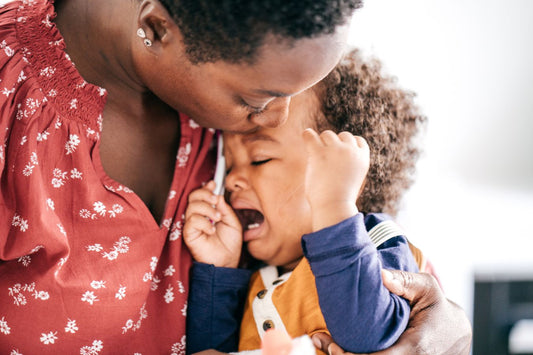By: Dr. Nikki Sharoupim, PsyD.
Tantrums are developmentally normal for toddlers

“NOOOOO! I don’t want that cup! I want the blue one! No, no, no!!”
And, cue the tears and meltdown while you are on your last straw after having cooked dinner for everyone.
You picked out a band aid for your toddler because they asked for one. But YOU picked it, not them. So they throw themselves on the floor, roll around, and cry. (Yes, my 18-month-old really did this).
You cut your kiddo’s sandwich diagonally, because that’s what they normally like, but now they want you to put it back together and cut it down the middle. As parents, I think it is safe to say we’ve all been there…
I know you’re thinking to yourself,
“Is this even real life? Am I getting Punk’d?”
You are not alone. To you, none of this seems rational.
Tantrums are developmentally normal for toddlers. However, just because they’re normal does not mean that you have to take a backseat and just let it happen.
Let’s break the tantrums down, learn some strategies to minimize them, and practice strategies to work through them (without ripping all your hair out in the process).
BIG FEELINGS, LITTLE BODIES

So, what exactly is a tantrum?
A tantrum is defined as,
“a sudden, intense outburst of emotion expressed with crying, screaming, shouting, stomping, hitting, or other such forms of physical or verbal expression.”
Think back to the most recent tantrum your toddler displayed. Do you think you can identify what may have triggered it?
Some common triggers of tantrums can include:
- Hunger
- Overstimulation
- Tiredness
- Seeking independence and/or power
- Attempts to avoid a task
- Attempts to gain access to something (tangible or attention)
“Toddlers are not mini adults.”
I bet many of you are thinking, “Okay, so if my toddler is hungry or tired, why can’t they just tell me? That would be so much easier and more productive than screaming and crying.”
Well, yes, it would be easier, and it is easy for an adult to do (maybe). Let’s take a step back and remember that toddlers are not mini adults.
They do not yet possess the same communication and emotional regulation skills that many adults have.
The area of the brain that is responsible for emotional regulation, planning, impulse control, and problem solving/logical thinking ( A.K.A. the frontal lobe) is the last to develop.

Here is a little secret:
Your brain isn’t considered ‘fully developed’ until you’re 25 YEARS OLD.
Therefore, tantrums often occur because toddlers lack the skills to properly handle big emotions and effectively communicate their needs; they cannot “think through” the situation like you and I can.
Now let’s try to put it in perspective…
As an adult, I’m sure you can think of a few things that annoy you. Maybe the barista put the wrong flavor of syrup in your drink.
Or maybe the shirt you wanted to wear is still in the laundry pile and you have to pick something else to wear.
Now you have two options – throw a fit and start to scream and cry or you can engage in some quick problem solving and think through a different way to handle these problems. Yes, you may be frustrated, annoyed, sad, etc.– and it’s valid to feel these emotions and to express them *appropriately.*
As an adult, through experience and communication with others, you learned how to handle these big emotions in a way that is conducive to receiving help. Remember, your little does not have this ability, yet.

So why does logic and reasoning not work when they’re in the middle of a tantrum?
Going back to an earlier example, the sandwich tastes the same even if it’s not cut the exact way they want, right?
Think back to your own examples of what annoys you. You can wear something else, can’t you?
When these things happen, how would you feel if you just wanted to vent and the response you receive is, “get over it, it’s not that big of a deal.”
All you wanted to do was communicate your dissatisfaction and you were dismissed. Now think about how your toddler feels when you tell them that not getting the blue cup they wanted isn’t a big deal. To you, it’s nothing, but in their mind, it was important.
This is their way of communicating their dissatisfaction and is the only way they know how to. When a tantrum is starting, notice the emotion and their experience and validate their feelings instead of dismissing them.
- “You really wanted _________”
- “I hear you, it’s frustrating.”
- “I love you and we will work through this together”
- “I can tell something is wrong. What do you need right now?”
DURING THE TANTRUM

Your little isn’t trying to give you a hard time, they’re having a hard time.
What does a tantrum look like with your little?
In my house, it’ looks like this: screaming and crying so loud that my husband’s Apple Watch alerts him that the decibel level is too high, toys are thrown, feet stomping all over the house, and sometimes, between the gibberish and tears I can make out, “that’s not fair!” or “I want it!” Your kiddo’s body is emotionally charged, and they physically do not have the ability to listen to and comprehend rational thinking.
Your little isn’t trying to give you a hard time, they’re having a hard time.
Expressing emotions and regulating their body is a skill that is learned and developed over time. And most importantly, it is learned by observing models.
Kids model the behaviors they see. This is why keeping yourself grounded and calm is critical (keep reading on to get some ideas on how to accomplish this).
Kiddos look to you to borrow your calm (co-regulation) while at the same time they’re learning how you handle tough situations.
My 18-month-old knows that when big bro is having a tantrum, it’s time to take deep breaths and splash water on his face.
So, at the first sign of a tantrum, the little one runs to the sink, runs his hand over his face (gesturing for the water), and then grabs a towel because he’s seen us do this exact routine many times.
RESPONDING TO THE TANTRUM

The more you talk or threaten punishment, the more likely you’ll see behaviors ramp up.
In order to get a rational thought in, you need to wait until their body calms down. It is NOT the time to:
- Lecture
- Threaten Consequences
- Isolate your kid
Their body is dysregulated, they are unable to process thoughts, and the only way they know how to communicate in the moment is through their actions AKA tantrums.
The more you talk or threaten punishment, the more likely you’ll see behaviors ramp up.

Instead, physically get on their level, put yourself in close proximity to them, use a calm voice (I know, this is tricky when you’re ramped up too), and lend your calm.
Another way to respond to the tantrum and model appropriate coping strategies is for you to label and share your feelings. You might say something like, “I need to take some breaths to calm down, I’m feeling a little frustrated right now.”
As mentioned earlier, validate their experience (e.g. I can see you’re having a tough time right now, I’m here for you. Let’s think of a way to calm our bodies down so we can figure out what we want for a snack/what’s upsetting you/how we can fix the problem).
With that, offer a strategy or two for calming down. If your kiddo is too worked up and cannot choose, let them know that you will choose for them to help them regain control of themselves.
CALM DOWN STRATEGIES FOR YOUR KID

*Try a few different strategies when everyone is in a calm state as a bit of practice for the tantrum so you know what could work when your little needs it (tantrum time)*
- Deep breaths. Simply saying, “let’s take some deep breaths” may be frustrating. Remember, your kiddo is little; make it fun and distracting.
- Space and time – Some kiddos (and adults) just want to be left alone to regulate. This doesn’t mean that you need to leave them sitting in their room, on the other side of the house. You can give them space but still be in proximity, letting them know that you are available to talk when they feel ready.
- Go for a walk – This gives them the chance to leave the environment that may be triggering and focus on something else. Try to get some fresh air.
- Distract and try to make them laugh – humor is often a good way to diffuse and distract. You don’t want to keep dwelling on the tantrum or whatever is making them upset. You want to help them move past it in a healthy way.
These are just a few ideas of calm down strategies that could work, depending on the precipitating event, your kiddo’s temperament, the state of your own emotions, and what you have access to at the moment.
There are many different strategies - it’s not a one size fits all type situation. Try to work with your kiddo to pick a few that they’d be willing to try.
Stay tuned for a more in-depth blog on coping strategies. And remember, just because one strategy worked for one tantrum, doesn’t mean it will work every time.
- Dr. Nikki Sharoupim, PsyD.





















